Online Survey Advantages and Disadvantages


Survey advantages and disadvantages. In other words, how to maximize the good and minimize the bad.
The business world today is customer-centered. Most companies have KPIs in customer experience they're tracking.
Only when you gather data about your customers can you create the perfect product and marketing strategy to attract them.
That’s what surveys are best for - to gather reliable data and boost your business’ success.
This article will teach you about the most popular of all data collection methods - surveys, as well as its advantages and disadvantages.
If you can't wait to send your own surveys, start using Trustmary for free to create your first survey ⬇️
What is an Online Survey?
To evolve and improve the services they offer, businesses of today must learn how to attract and keep customers happy. It’s not easy to keep a tab on customers’ likes and dislikes, needs, and demands.
However, one thing can help you do this fast and efficiently - an online survey.
Conducting surveys regularly and at different stages of the customer journey is a great way to learn how they perceive your product, services, and your brand.
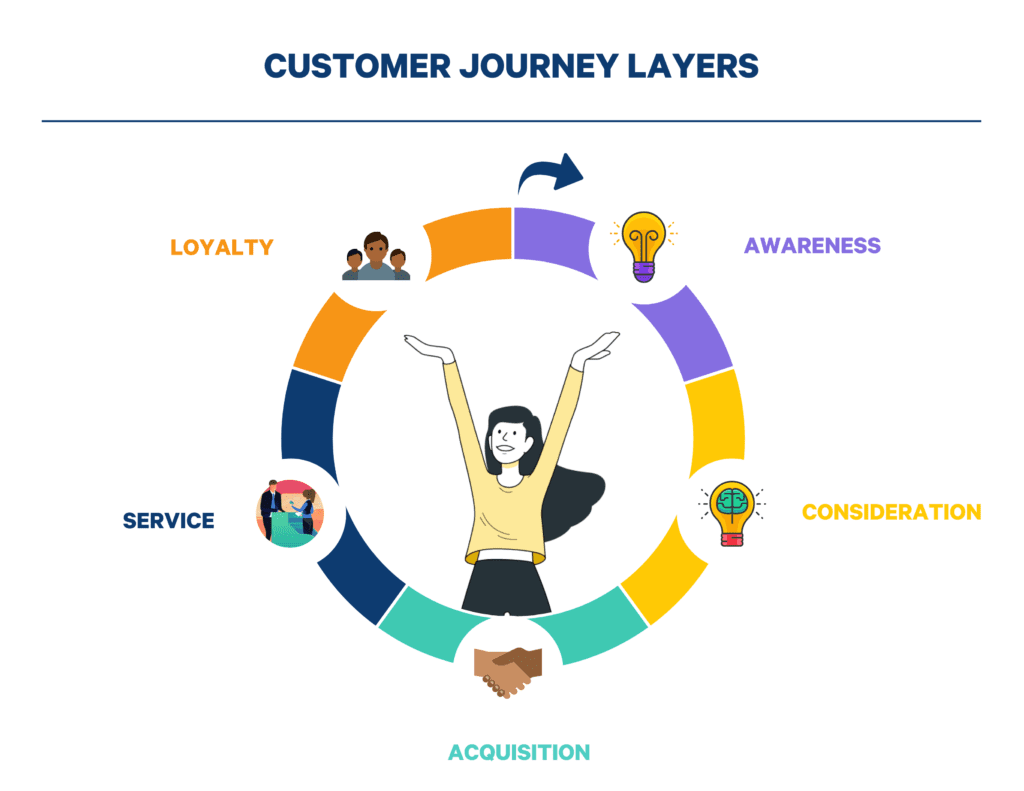
Surveys come in many forms and sizes. They are used to facilitate market research. Once you create effective survey questions and design the form, you need to send it out to customers to fill out. Based on the responses, you can analyze data to improve your brand.
But, let’s not rush into this.
Before you move forward and start working on your surveys, it’s important to learn more about them.
For starters, we’ll tell you about the advantages that surveys can bring to your brand.
Next, we’ll talk about the disadvantages and how to avoid them.
Let's go over how to set up the customer survey process by using Trustmary.
Book a free meeting to hear how you can get:
- >20% response rate to survey
- 40% review rate from respondents
- Public review page
Top 9 Advantages of Online Surveys
Here are the main advantages of conducting surveys online in 2022.
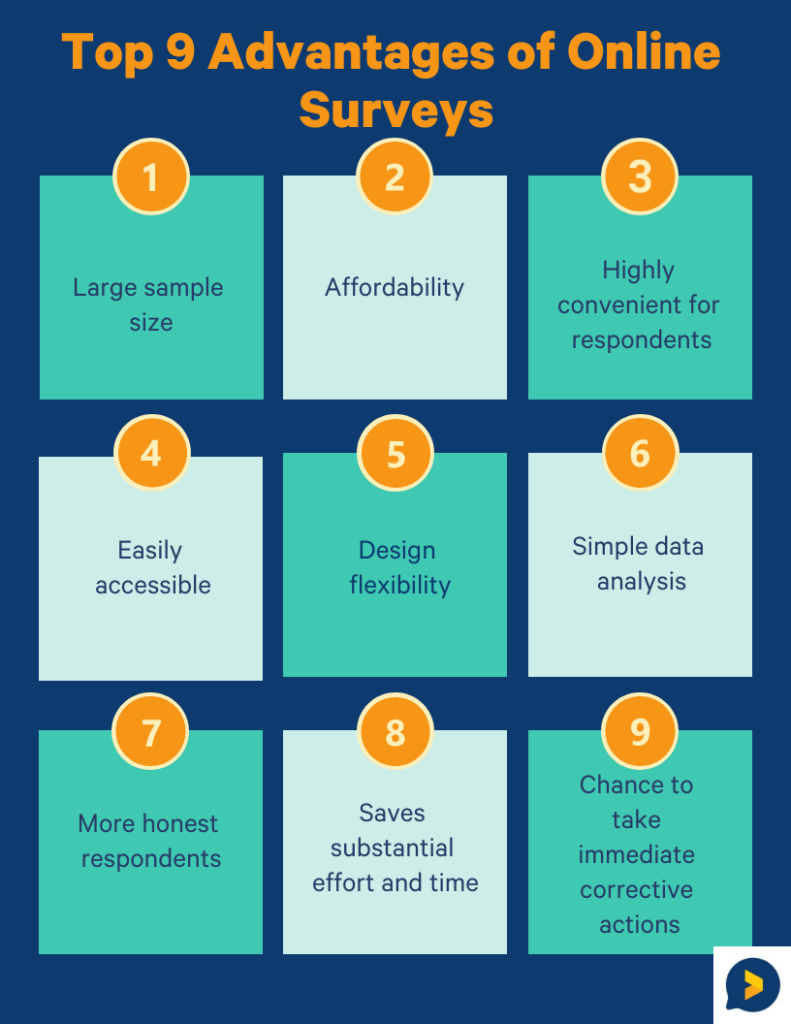
1. Large Sample Size for Market Research
Before an online survey was an option, the only way to gather data was to ask customers one by one for their feedback about your services, products, and company. Today, data collection is easier than ever. These surveys have an enormous reach, much bigger than most other data collection methods.
Gathering data manually can take forever and small samples aren’t very accurate and specific. Online surveys, on the other hand, can test hundreds, if not thousands of participants and reach subjects from every corner of the world.
Depending on the range of your business, the purpose of your surveys, as well as your goals with the survey research, you can use them to collect reliable data in a very short time.
When we say ‘larger sample size’, it’s important to mention people who would otherwise be unable to share their feedback with traditional methods. These include people that are far away or people with a visual or hearing impairment. For them, it’s much simpler to fill out an online form and share their experience, which is very important to learn for you as a brand.
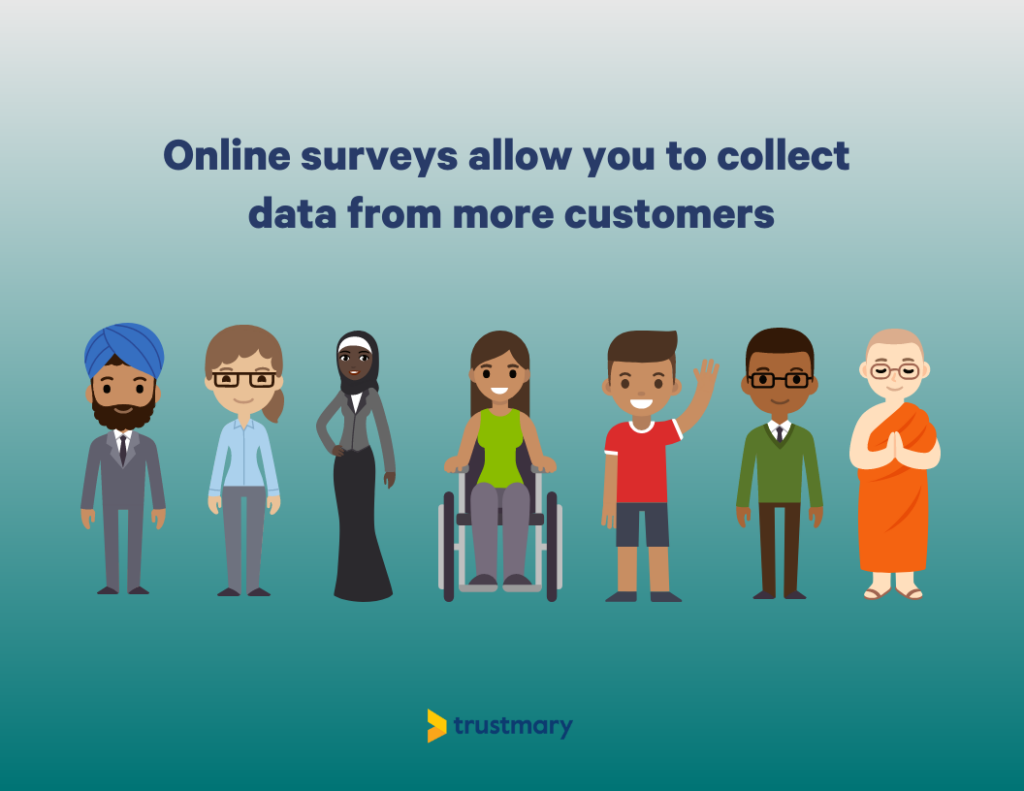
2. Affordable Method of Gathering Data
Collecting data can cost a fortune and take forever if you do it the old-fashioned way. Thanks to surveys, you don’t have to spend a fortune on this any longer. These types of surveys are not conducted in-person, which saves money on travel, doesn’t require hiring interviewers and more.
With the emergence of survey research online, things have changed significantly. You don’t have to print out the forms, travel to customers that leave far away, etc. All you need to do is invest in a smart survey maker tool like Trustmary, customize your forms and design your survey questions, and send them out - all at half the cost!
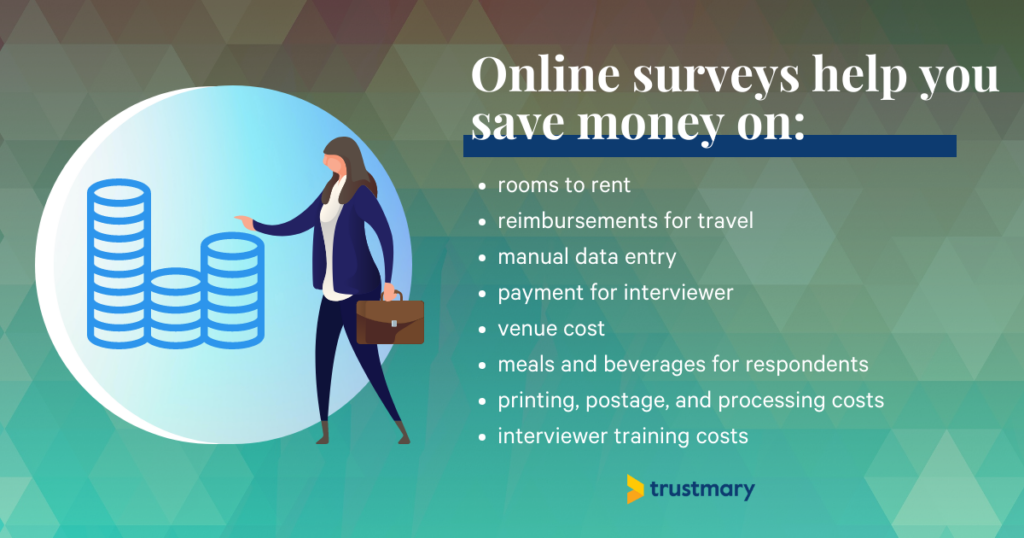
3. Highly Convenient for Respondents
In-person surveys don’t offer much flexibility and convenience to the respondents. They have to talk to the interviewer in a set time, answer questions fast, and complete the interview within a set timeframe.
With surveys conducted online, respondents enjoy a lot of flexibility. They can decide whether or not they want to complete them, when they want to complete them, and think about the questions for as long as they need to.
In other words, when you send your surveys online, you are allowing respondents to pace themselves at their convenience. This leads to more accurate, well-thought responses from respondents that are relaxed and not at all pressured.
4. Easily Accessible
Now that we all have our smartphones on us most of the time, filling out surveys is very accessible and convenient. When you send out your mobile surveys, you are giving respondents the option to open and fill them out when they feel comfortable. They can do this on their work break, before going to sleep, or while they commute to the workplace.
Ease of accessibility equals more convenience for the respondents, which can positively affect the quality of the data you collect.
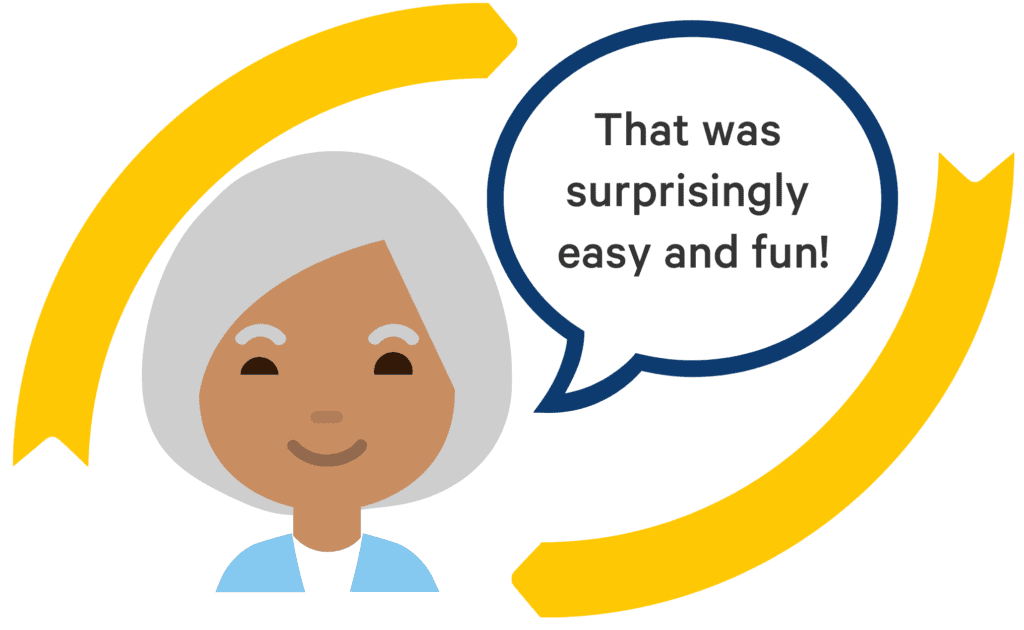
5. Design Flexibility
Thanks to amazing tools like Trustmary, you can design, customize, edit, and program surveys in any way you want. You can create layouts, pick different fonts and sizes for the questions, add all sorts of visuals to your surveys, and much more with an easy-to-use survey-maker.
The more attractive you make your surveys, the better.
Since surveys online are flexible with the design, this allows you to create different types of surveys with ease. Depending on the customer journey stage and your goal in terms of survey research, you can create and send NPS email surveys, create CSAT or CES surveys, and ask open- and closed-form questions in mixed online questionnaires.
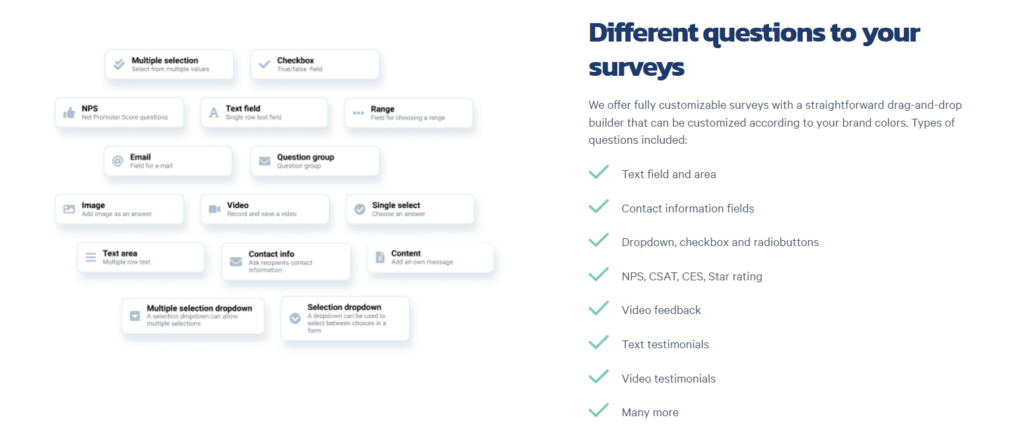
You can customize and edit just about everything from the order of your questions to the colors and design. You can even automate the surveys to change based on the respondents. For example, your survey can skip questions based on the respondent’s answer to the previous question.

6. Simple Data Analysis
Compared to qualitative survey research techniques like interviews and focus groups, sending out surveys online makes analysis much simpler.
Surveys often provide quantifiable data, especially when they include closed-form questions.
Once you perform your survey research and collect quantitative data, analyzing it is pretty straightforward. In addition to data gathering, you can use a variety of tools to analyze the survey data and determine the statistical significance, validity, and reliability.
What used to take researchers hours to analyze now takes only minutes, all thanks to artificial intelligence and technology-driven market research.
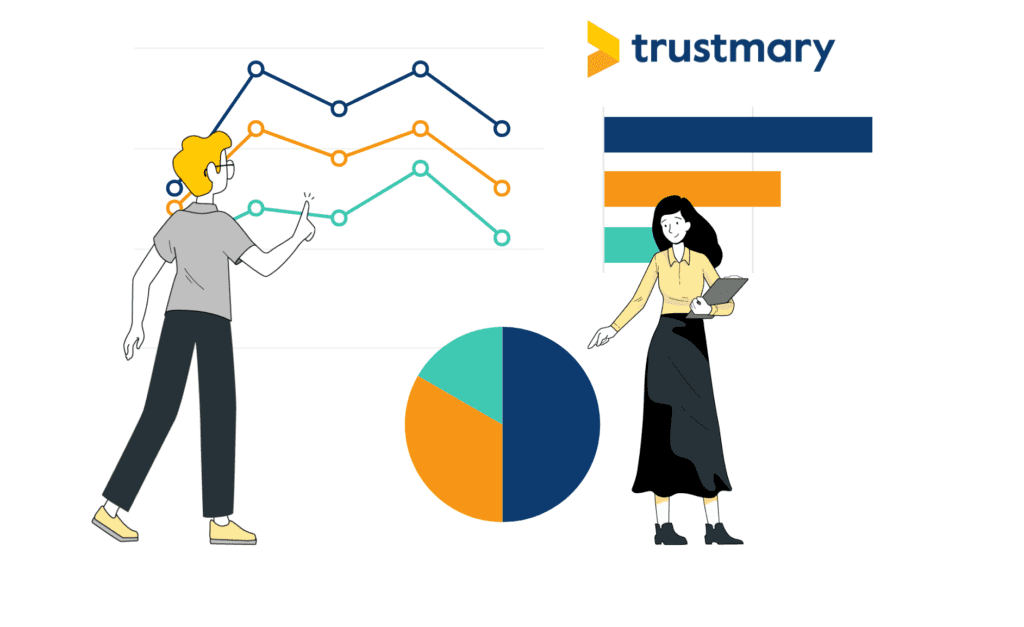
7. More Honest Respondents
When you interview someone in person, there’s basically no anonymity even if you keep their name out of forms and documents. When you send out anonymous surveys or give respondents the option not to share their identity, you are making this much more convenient for them.
Honesty is the most important part of data collection. When asked directly and without anonymity, people can clam up and offer dishonest answers, sometimes intentionally and sometimes because they are very stressed.
If you want to get honest answers from your respondents, this type of survey research is of tremendous help.
8. Saves Substantial Effort and Time
Survey research conducted online is not only cost-effective but also time-efficient. You won’t have to manually ask every person all of the questions and wait for their answers, note them down, copy them, and go through them to come up with actionable data.
Online surveys take less time and effort in every way. They are easier to design, easier to conduct, and easier to analyze. It suffices to say that, by performing this type of survey research, you can dedicate your time to other tasks or even create more surveys to use for your brand.

9. Chance to Take Immediate Corrective Actions
Survey invitations are not pushy. Your customers get the opportunity to decline to answer them. They can take all the time they need to answer, and skip any question they dislike. They can access the surveys at any time and from any device they prefer to use.
This is a great deal of flexibility and convenience which, of course, leads to higher customer satisfaction. Since you can conduct them rapidly and analyze the results fast, you can take immediate corrective actions and fix the issues of your customers.
Not only will respondents learn that your brand cares about their opinions, but you can utilize their individualized answers to win back customers you might have lost, as well as improve your service.
The 5 Main Disadvantages of an Online Survey
Surveys can be very advantageous, but not always. There are some disadvantages of surveys that you should be aware of. Some of these can be avoided if you create and conduct the right survey at the right time. However, to avoid them you first need to be aware of them. Therefore, here are the 4 main disadvantages of surveys today.
1. High Abandonment Rates
Let’s be realistic - the response rate of surveys is not always very high.
Even if you create the best form, some people will be busy or simply unwilling to spend their time filling it out.
This is the case with lengthy email surveys.
However, very often, it is not the respondents’ fault that you get high abandonment on your survey. Some of the things that can cause this are accessibility issues, surveys that are too long or too complex, questions that are too broad or have a hidden agenda, etc.
How to Avoid This Disadvantage
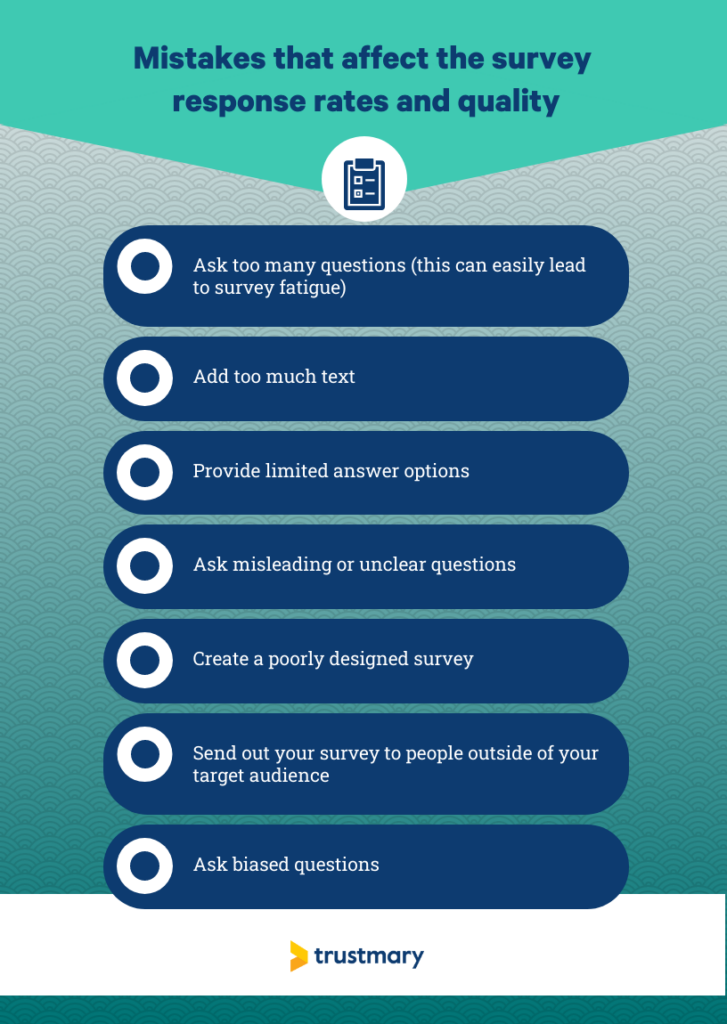
Here are some examples of biased survey questions to look at.
If you just avoid these issues when creating your survey, you can minimize the abandonment rates and get more data from your survey research.
2. Respondent Bias and False Information
One of the best ways to prompt recipients to answer your questions is to offer them some kind of incentive. This is a great way to gather information since you’re offering them something in return for a bit of their time. However, it can also lead to them providing false information.
Some recipients will just click their way through your questionnaire without paying much attention to the content. Not all of them will look closely, think, and offer honest and accurate answers.
False statements in surveys are a frequent issue but, if you send out your forms to the right people and obtain tons of useful data, this shouldn’t ruin the reliability of the results.
You might also get inaccurate information due to response bias. People tend to respond dishonestly or inaccurately out of fear of being judged, because of their financial situation, because of personality or cultural differences, etc.
We are also looking at problems such as social desirability bias, financial stability bias, and questions that confuse or are too complicated for the respondents.
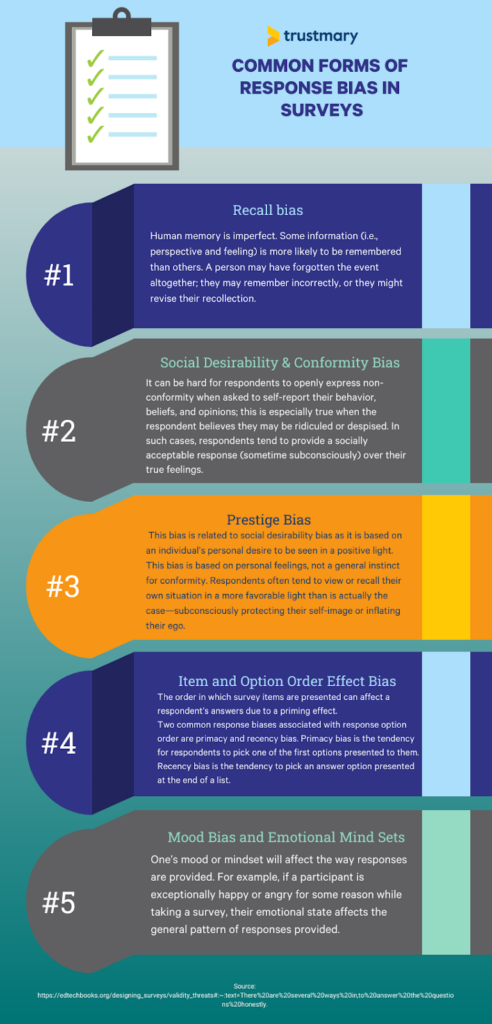
How to Avoid This Disadvantage
To avoid these disadvantages, it is important to ask the right questions. If you want to collect data that is honest and accurate, you need to avoid indirect questions, use personalized content, consider your target audience’s background, etc. This do’s and don’ts of product surveys guide should help you when forming your questions.
If people are rushing to complete the form to get the perk you’re offering them, you can set a minimum response time to force the users to slow down, or include some trick questions to check if they are reading them carefully.
3. Online Limitations
Some of your target audience won’t have internet access. Some won’t open their email as often as you’d want them to. For many businesses, the target audience includes older demographics. This group is not as proficient at using the Internet to fill out forms, so you are looking at poor accessibility options for them.
How to Avoid This Disadvantage
While you might not be able to reach out to all people in your target audience, you should do your best to find a way to get data from as many of them as possible. There’s nothing wrong with using different forms of research. If you have people that don’t have online access, why not conduct interviews with them?
4. No Interviewers
In many ways, this is considered a benefit since this type of survey has lesser pressure on the respondent and can take a lot less time. However, in some cases, the lack of an interviewer can be seen as a disadvantage.
Why is this?
A skilled interviewer can get important answers out of participants that aren’t very forthcoming with responses. They can also follow up instantly after receiving an answer and ask a question based on what the respondent says. They can view the body language and determine the reliability of the answers.
When you create and send out ready surveys, it’s not possible to change the questions mid-way, add questions or discuss the answers thoroughly with the respondent.
How to Avoid This Disadvantage
While it’s not exactly possible to view the body language of respondents or ask questions out of a sudden, you can customize the surveys to ask questions based on your assumptions regarding their answers. It’s also very important to ask the right questions.
5. Misunderstandings and Varying Expectations
No matter how well you understand what you mean with your questions, there will likely be someone who has a very different understanding of the question.
You might also expect a certain type of response, but you might get something else.
I can lay out a concrete example: Finnish people usually use the minimum number of words. If you ask them in a feedback survey "What made you give us 5 stars?", they might answer with just one word. "Professionalism." "Efficiency." Because the sentence "Efficiency made me give 5 stars" makes complete sense.
While you might expect a lengthy answer, you might only receive one word.
How to Avoid This Disadvantage
So how to avoid misunderstandings and align expectations?
A 100% sure solution doesn't exist, as people are different. But you can try to avoid this by reviewing the questions closely and trying them on different people before running the actual survey.
You can add descriptions to questions requesting a certain length of response. For example: "Please respond with 1-3 full sentences."
Our guide on survey design can help you create as unambiguous and effective surveys as possible.
Alternatives to Online Surveys: Pros and Cons
When considering alternatives to online surveys for market research and customer feedback, several methods can provide valuable insights, often offering richer data or different perspectives.
Here are some key alternatives:
1. Focus Groups
- Description: Small groups of participants are brought together to discuss specific topics in a moderated setting.
- Advantages: Allows for in-depth discussion, real-time feedback, and the opportunity to explore complex issues in detail. The interaction between participants can reveal insights that might not emerge in individual surveys.
- Disadvantages: Can be expensive and time-consuming. Results may also be influenced by dominant participants or groupthink.
2. In-Depth Interviews
- Description: One-on-one interviews where an interviewer explores a participant's thoughts, feelings, and experiences related to a particular topic.
- Advantages: Provides detailed, qualitative data and allows for probing questions to clarify responses. Ideal for understanding motivations, attitudes, and perceptions.
- Disadvantages: Time-consuming to conduct and analyze. The quality of data can depend heavily on the interviewer’s skills.
3. Ethnographic Research
- Description: Researchers observe participants in their natural environment to understand behaviors and cultures. This can involve shadowing customers in stores, observing product usage, or even living alongside participants for a time.
- Advantages: Offers deep insights into real-world behaviors and contexts, often uncovering needs or pain points that participants might not articulate in surveys.
- Disadvantages: Extremely time-consuming and expensive. The presence of the researcher may also influence participant behavior (observer effect).
4. Mystery Shopping
- Description: Researchers pose as customers to evaluate the quality of service, product availability, and overall customer experience.
- Advantages: Provides real-time insights into the customer experience and helps identify gaps in service delivery.
- Disadvantages: Only suitable for retail and service industries, and the findings might be subjective, depending on the mystery shopper’s perspective.
5. Social Media Listening
- Description: Analyzing conversations, mentions, and trends on social media platforms to gather insights about customer opinions and market trends.
- Advantages: Captures spontaneous, unfiltered opinions and real-time reactions. It’s a cost-effective way to monitor brand perception and industry trends.
- Disadvantages: Data can be overwhelming and difficult to analyze without the right tools. It also lacks the depth of insight that direct questioning can provide.
6. Customer Feedback Forms
- Description: Feedback forms placed at the point of sale, in product packaging, or emailed after a purchase, allowing customers to share their thoughts.
- Advantages: Collects feedback from actual customers at relevant touchpoints. It’s often simple and inexpensive to implement.
- Disadvantages: Response rates can be low, and the feedback may be less detailed than that obtained through interviews or focus groups.
7. Behavioral Data Analysis
- Description: Analyzing customer behavior through transaction data, website analytics, or CRM systems to understand patterns and trends.
- Advantages: Provides objective, quantitative data on actual behavior rather than self-reported information. It’s useful for identifying trends and forecasting.
- Disadvantages: Doesn’t explain the “why” behind behaviors, which can limit the depth of insight. Requires sophisticated data analysis tools and expertise.
8. Experimental Research
- Description: Conducting controlled experiments to test hypotheses about consumer behavior. This can include A/B testing in digital environments or product trials in real-world settings.
- Advantages: Allows for testing cause-and-effect relationships and optimizing strategies based on empirical evidence.
- Disadvantages: Can be complex to design and execute properly. Results might not always be generalizable outside the experimental setting.
9. Secondary Data Analysis
- Description: Analyzing existing data from other sources such as industry reports, academic studies, or government statistics.
- Advantages: Cost-effective and time-efficient since the data is already available. Useful for understanding broader market trends and benchmarking.
- Disadvantages: The data may not be perfectly suited to your specific research questions, and it might be outdated or lack the detail needed for actionable insights.
Each research method offers unique advantages and is suited to different research objectives. The choice of method depends on factors like the depth of insight required, the target audience, the resources available, and the specific goals of the research. Often, a combination of these methods can provide a more comprehensive understanding of the market and customer behavior, allowing you to make more informed decisions.
Summary of Online Survey Advantages and Disadvantages
Here's a table to break down the advantages and disadvantages of surveys.
| Advantages | Disadvantages |
| Large sample size | High abandonment rates |
| Affordability | Respondent bias |
| Convenient for respondents | Not accessible to all |
| Accessible | No personalized follow-up questions |
| Design flexibility | Misunderstandings and varying expectations |
| Honest responses (due to anonymity) | |
| Simple data analysis | |
| Ability to react quickly to any issues | |
| Saves effort and time for sender |
Automate Your Online Survey Process for Best Results
If you want to really use the perks of surveys, you need the right tool to make this happen. With a handy tool like Trustmary, you can easily
- Create your survey forms
- Conduct research on the happiness of your customers, and
- Get reports and analytics within a very short timeframe.
What's better is that you can turn customer feedback into reviews! Reviews can be embedded in your website to create social proof for your brand.
Did you know that you can even embed surveys on your website?
Create Customer Feedback Survey – in Minutes
In case automating your online or embedded email surveys isn't an option for one reason or another, but you still want reviews, try review campaings.
With Trustmary, you can easily set up a campaign to, for example, get more Google reviews.
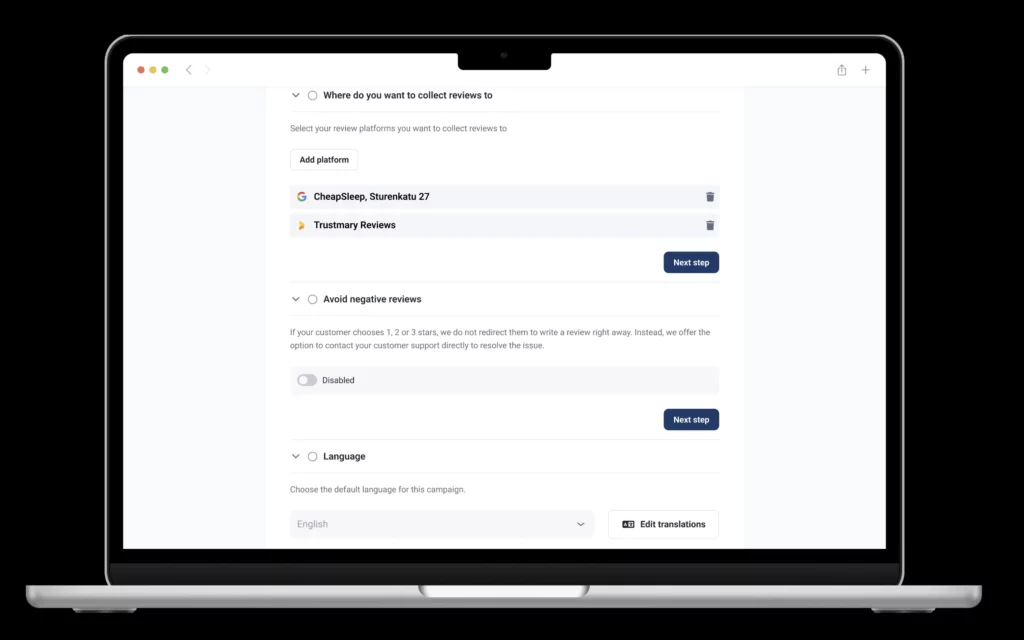
Setting up a review campaign has never been easier, faster or cheaper.
Start now by typing your Google my Business location below
You can customize:
- Language
- Messages themselves
- If and when a reminder is sent
- Review site the reviews are collected to
- Avoiding negative reviews (so you can resolve the matter offline!)
Wrapping Up
There are advantages and disadvantages of any form of research used today, but we can all agree that, when it comes to online surveys, the advantages seriously beat the disadvantages.
If you want to create better surveys, take a look at these survey subject line examples to get you started. How you form your online questionnaire depends on what you want to achieve with your survey research. So, take your time, brainstorm on your ideas, and use the right tool to create and conduct your surveys.
FAQ
What makes a quality online survey?
Quality surveys provide the respondents with the option to answer or not answer the questions. They look good, are presented well, and do not overwhelm the recipient. For a survey to yield good results, it has to ask the right questions.
What is the purpose of an online survey?
The purpose of conducting online surveys is to collect data from your customers to gain insights that will help you improve your brand’s image, the quality of your products and services, and customer service.
When should I be conducting surveys?
You can conduct an online survey at different points of the customer journey. The type of survey you’ll create and the answers you’ll ask depend on your goals, as well as the stage of the customer journey.
What are the most popular types of online surveys?
The most popular types of surveys are customer satisfaction, NPS, product surveys, CES, etc.
Are online surveys reliable?
In all surveys both offline and online, survey bias is present to some extent. However, you can significantly reduce bias by avoiding the most common biased questions.
With online surveys, the contact list you have determines the reliability. If you're sending a survey to 200 of your clients, you can draw some sort of conclusions based on the answers.